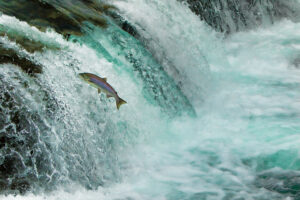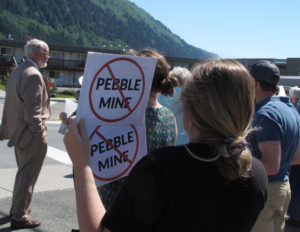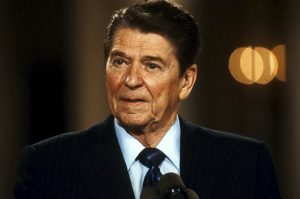How Oil Industry Lobbyists Played the Long Game to Access a Fuel-Rich Corner of Alaskan Wilderness
The story of how the oil company ConocoPhillips overcame years of resistance from courts, native Alaskans, environmental groups and several federal agencies reveals the truth about how Washington really works. Joseph Sohm / Shutterstock
1
2
3
Joseph Sohm / Shutterstock
1
2
3
The agitation in Alaska was bipartisan: the Democratic governor, a Yale-educated Vietnam veteran named Tony Knowles, was also fretting about the declining flow. The job of mollifying him fell to Bruce Babbitt.
Babbitt had been the natural choice at Interior for Bill Clinton. The laconic former Arizona governor was a founding member of the Democratic Leadership Council, the centrist reform group that had given rise to Clinton, and then ran the League of Conservation Voters.
“My job is to stand at the border with a flaming sword” to defend the wildlife refuge, Babbitt once said. But he saw nothing inconsistent about offering the oil companies NPR-A as a consolation prize.
“Babbitt was enthusiastic about opening up NPR-A if it was done on the right terms, and I agreed with him,” recalled Knowles. Babbitt confirmed this account: “It was clear to me that we had to look west.”
Doing it right meant not letting the reserve end up like the North Slope around Prudhoe Bay under the anything-goes oversight of the state of Alaska, a sprawl of drilling pads, gravel mines, pipelines and roads. It meant limiting the impact on natives, particularly the Inupiat living in the village just east of NPR-A, Nuiqsut.
And doing it right meant protecting Teshekpuk Lake, at 30 miles wide the largest in the Alaskan Arctic. The lake happens to be smack in the middle of the part of NPR-A thought to have the richest oil fields, its northeastern corner. Yet this area is also so full of wildlife that it had long been considered inviolable — even by James Watt, who as President Reagan’s Interior secretary was the closest thing to an avowed enemy of the conservation movement.
Teshekpuk was the calving and summering grounds for a 60,000-head caribou herd. There were tundra swans that migrated to the Chesapeake Bay, buff-breasted sandpipers that headed for Argentina, yellow wagtails that wintered in Southeast Asia, and, trumping them all, bar-tailed godwits that flew 8,000 miles to New Zealand. Some 37,000 black brant geese, a large share of the global population, even molted at the lake.
To Babbitt, the region’s wildlife was “absolutely transcendent.” He thought he’d found a balance to protect precious watersheds and native hunting and fishing grounds. The drilling in NPR-A would emulate a low-impact project that was being pioneered by the oil company Arco just east of the reserve. Arco was managing without permanent roads, limiting itself to seasonal drilling, occasional helicopter flights, and ice roads — an underlay of crushed ice with water pumped along it that, once frozen, is scarred for traction. In spring, it melts away.
“There was a relentless endorsement by everyone in sight that this was the wave of the future,” Babbitt said. “The problem with roads is that roads beget more roads beget more roads. A road becomes a network, becomes a spider-web of landscape fragmentation and destruction, with little use for wildlife.”
He released his plan in 1998. It allowed leasing on a 4.6-million acre swath in the reserve’s northeast but expanded the protected areas that Watt had defined around Teshekpuk Lake to about 600,000 acres. It also called for a three-mile buffer along Fish Creek, a stretch close to Nuiqsut that villagers relied on heavily for fishing and hunting.
The oil companies seemed to buy in, as Arco and BP snatched up leases. And by the time Babbitt left Interior in 2000, he had reason to believe it was a settled matter.
‘Where Your Principals Are’
In May of 2001, Andrew Lundquist took the podium in a banquet hall at the Hyatt Regency in Washington to tell the assembled guests about a new report on energy. He spoke in bland terms about a “substantive, forward-looking and truly comprehensive” proposal that increased “environmentally friendly exploration and production of domestic energy resources.”
Two weeks earlier, President Bush had released a 170-page plan to overhaul the nation’s energy policy. The plan had been produced by a Cabinet task force led by Vice President Cheney, just off a five-year stint as chief executive of oil-services giant Halliburton. Cheney’s imprint on the plan was not hard to discern. It called for building up to 1,900 new power plants, many of them to be fueled with coal. (The report made only passing mention of climate change.) It recommended exempting the chemicals used in hydraulic fracturing — fracking — from the Safe Drinking Water Act. It proposed opening the Arctic National Wildlife Refuge to drilling.
And it called for expanding drilling in the National Petroleum Reserve-Alaska. Specifically, “such consideration should include areas not currently leased within the Northeast corner of the Reserve” — that is, the areas around Teshekpuk Lake that Babbitt had shielded.
The report’s familiarity with the fine points of the Alaskan landscape was hardly surprising, given that its production had been managed by Andrew Lundquist. Plucked from the Senate to serve as the task force’s staff director, he ran meetings in Cheney’s absence, served as the contact point for the energy companies that clamored to influence the report, and handled the flow of drafts from more than 100 administration staffers across multiple departments. He was the hub of the action, the final word.
As he had in the Senate, Lundquist looked for areas of consensus, seeking to add some language on conservation and renewable energy. But he knew not to push too hard on that front, given Cheney’s inclinations. In a moment of candor Lundquist had explained his career strategy to a senior White House colleague. “He once said to me, ‘You’ve got to take your initiative but cover your ass — take risks but don’t get too far ahead of where your principals are,'” the former colleague recalled. “He knew how to comport himself.”
As reward for such comportment, Lundquist was promoted to White House energy policy director. He devised a plan to win House approval for drilling in the wildlife refuge, by limiting the drilling to 2,000 acres of its coastal plain. But the proposal stalled in the Senate, where Democrats hung onto a slim majority.
The Sept. 11 attacks did little to derail the administration’s energy fixation. As the White House pushed to turn the task force recommendations into law, it was besieged by demands from government auditors and environmental groups for records of meetings that Lundquist and Cheney had held with more than 150 energy companies and trade groups. Cheney fought disclosure all the way to the Supreme Court. At the heart of the fight was Lundquist, who was personally subpoenaed in April of 2002.
The subpoena would not have been legally necessary if Lundquist was still in the administration. But he was not. Just a few weeks earlier, after barely more than a year in his position, he had left it to strike out on his own.
‘Cash Flow Perspective’
In the early 2000s, much of Washington seemed suddenly awash in money. Luxury stores and restaurants sprouted in a landscape never known for its glamour; by decade’s end, half of the nation’s wealthiest counties were to be found in the Washington area.
The wealth was being driven in part by the post–9/11 proliferation of contractors capitalizing on the surge of spending on homeland security. But also responsible was an older Washington industry: lobbying.
Companies were learning that the spread of earmarks — specific spending appropriations tucked into larger bills — made it all the more advantageous to have lobbyists working Capitol Hill. Meanwhile, the worsening gridlock in Washington meant that ever more consequential actions were coming straight from the executive branch. Lobbyists familiar with the inner workings of the bureaucracy were highly desirable. From 2000 to 2010, money spent on federal lobbying more than doubled, to $3.52 billion, and most of this growth could be attributed to the expanding ranks of revolving-door lobbyists.
Lundquist caught this wave at the right moment. Nine months after he left the White House — Jan. 1, 2003 — he registered the Lundquist Group, LLC, with an office on New York Avenue less than a block from the White House complex.
Under a 1978 law, one of the post-Watergate reforms, former top administration officials were not allowed to lobby their old agencies within a year of leaving office. Lundquist was at risk of violating that, since his registration occurred only nine months after his departure.
But the lines around what counted as lobbying were so gray as to make the law all but unenforceable. There was nothing to stop former officials like Lundquist from sharing intimate knowledge of the government with their new business associates, enabling lobbyists to deliver perfectly customized pitches. Challenged by reporters about whether his registration fell within the off-limits period, Lundquistasserted he had made no improper contacts with his former colleagues at the White House and Energy Department. “I stuck to the letter of the law on ethics rules,” he said.
In 2003, Lundquist reported collecting $300,000 in lobbying fees in addition to whatever he earned in other consulting — a big jump from the roughly $125,000 he was making at the White House. “Ultimately, a person has a family to support,” said Dan Val Kish, who worked with Lundquist on the Senate committee. “Money at the top levels of federal government is pretty good, but the private sector is much better.”
Halfway through 2003, after a year on his own, Lundquist, who has four children, sold his three-bedroom home in Arlington and bought a place nearly four times as big — a $1.48 million, four-bedroom, six-bathroom house with a pool on 1.75 acres in Great Falls, the affluent Fairfax County enclave further up the Potomac.
That Lundquist was in such high demand was no surprise — he was starting his business at the exact moment when Republicans were pushing for major energy legislation based on the plan he had shepherded. His clients in that first year included Toshiba Corp., which wanted to build a nuclear reactor in Alaska; British Petroleum; a Wyoming coal-mining company called Kennecott Energy; and Duke Energy, the electric utility giant. Each had a big stake in specific planks of the legislation.
His old boss Frank Murkowski was now governor of Alaska; the state became another Lundquist client. In 2004, he added Exelon, the large nuclear-power utility, and Coeur d’Alene Mines, a major silver and gold mining company whose board of directors he would join a year later. He was also on the board of an independent Texas oil drilling company, Pioneer. “There’s nothing I don’t work on in energy,” Lundquist told the Roll Call newspaper in 2004. “Energy has been a great niche for me.”
‘Our Top People Go’
When Lundquist made it back home to Alaska now, his Washington connections followed. Most summers, he would head to Prince of Wales Island for a weekend at the Waterfall Resort, a five-star fishing outpost reachable by boat or seaplane. On paper, it was a fundraiser for breast cancer prevention and treatment in rural Alaska, a cause taken up by Nancy Murkowski, Frank’s wife, and one of personal relevance for Lundquist, whose mother had breast cancer. But it also served as a summit for oil industry leaders and Washington Republicans, who could meet in seclusion, and return home with their salmon and halibut cleaned and vacuum-packed by the resort staff.
Most years, the charity spent more on the fishing weekend — the smallest package at the resort now costs $3,555 per guest — than it raised for its cause. By the mid–2000s, at least nine U.S. senators had attended the weekend over the previous decade. At least three had let the charity pay for their attendance, in contravention of Senate ethics rules, while several others, including then-Speaker Denny Hastert and Majority Leader Trent Lott, failed to disclose who paid for the trip.
In one picture from the event in the mid-2000s, Lundquist stood in dark rain-gear and flashed a tight smile for the camera, with Hastert and his wife on one side and Frank and Nancy Murkowski on the other. “Our top people go,” Red Cavaney, then the head of the American Petroleum Institute, told American Radio Works, a public-radio documentary unit, for a show that aired in 2006.
Your support matters…Independent journalism is under threat and overshadowed by heavily funded mainstream media.
You can help level the playing field. Become a member.
Your tax-deductible contribution keeps us digging beneath the headlines to give you thought-provoking, investigative reporting and analysis that unearths what's really happening- without compromise.
Give today to support our courageous, independent journalists.






You need to be a supporter to comment.
There are currently no responses to this article.
Be the first to respond.